
|
ANTIQUITIES OF THE MESA VERDE NATIONAL PARK
CLIFF PALACE
By JESSE WALTER FEWKES
MINOR ANTIQUITIES
In the preceding pages have been described the major
antiquities, such as walls and those permanent objects which could not
be removed from the places where they were constructed without more or
less harm. There remain to be considered the minor antiquities, or the
smaller objects which are movable and of a more perishable nature,
especially if left in the places where they were found. It was mainly in
search of such objects that much of the mutilation of Cliff Palace was
done.
It was not expected that excavations would yield any
considerable number of specimens, since for years Cliff Palace had been
dug over in search of them, and many hundreds of objects had already
been found and carried away to be sold either to museums or to
individuals. Notwithstanding these unfavorable conditions, the collection
of objects, now deposited in the National Museum, is sufficient to
afford some idea of the culture of the Cliff Palace people.
Among the objects that may be mentioned in the
category of minor antiquities are pottery, basketry, implements of stone,
bone, and wood, fabrics of various kinds, ornaments, fetishes, and
the like—all those objects commonly called artifacts that make up
collections from cliff-dwellings generally.
The excavations at Cliff Palace have revealed no
specimens strikingly different from those already described as from
Spruce-tree House. We would expect some variation in the symbols on
pottery from the two ruins, but the differences are not conspicuous in
the few specimens that have been compared. Nor is there any peculiarity
in the form of the pottery, as the ceramic objects from Cliff Palace
practically duplicate those from Spruce-tree House, already described,
and probably are not much unlike those still buried in Long House,
Balcony House, and the House with the Square Tower.
As many ceremonial objects, being highly prized, may
have been removed from Cliff Palace when the place was deserted by its
inhabitants the few that remained present scant material from which to
add to our knowledge of the ceremonial life of the people. The existence
of so many kivas would point to many rites, although a large number of
sacred rooms does not necessarily indicate more complex or elaborate
rites than a smaller number; multiplicity of kivas does not necessarily
mean multiplicity of ceremonies, nor few kivas a limited ritual. In no
pueblo are there more complicated ceremonies than at Walpi, where there
are only five of these sacred rooms; but it must be remembered that many
of the religious rites of Walpi are performed in kihus, or secular
rooms. The same may have been true of Cliff Palace.
The writer's belief is that in historic times, by
which is meant since the advent of missionaries, altars have become more
elaborate and rites more complex at Walpi than in prehistoric times, and
that through the same influence the use of images or idols has also
increased. This increase in the complexity of rites may be traced to the
amalgamation of clans or to a substitution of the fraternities of
priesthoods for simple clan ancestor worship. The elaborate character
of ceremonial paraphernalia may likewise be due to
acculturation,a which increases in complication with the lapse of
time.
aFor instance, the complicated reredos of many
of the modern Hopi altars is made of flat wooden slabs, the manufacture
of which would be very difficult for a people ignorant of iron. These
probably replaced painted stone slabs of simpler character, examples of
which have been found in ruins and indeed still survive in some of the
oldest rites.
STONE IMPLEMENTS
The stone implements from Cliff Palace consist of
axes, mauls, paint grinders, pecking stones, metates, balls, flakes,
spear and arrow points, and various other articles (pls. 20-22).
There is great uniformity in these implements, the axes, for instance,
being generally single edged, although a good specimen of double-edged
hatchet is in the collection. A fragment of the peculiar stone
implement called tcamahiab by the Hopi was found.
bThis object probably came from near Tokónabi,
the ancient home of the Snake people of Walpi, on San Juan river.
Fourteen of these tcamahias form part of the Antelope altar in
the Snake dance at Walpi.
While as a rule the hatchets are without handles, one
specimen (pl. 20) is exceptional in this particular. The handle of this
hatchet from Cliff Palace, like that from Spruce-tree House, elsewhere
described, is a stick bent in a loop around the stone head.

Plate 20. AX WITH ORIGINAL HANDLE
|

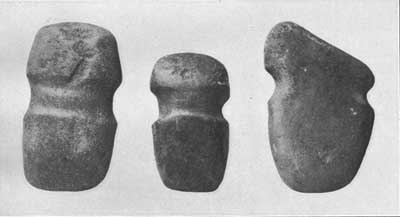
Plate 21. STONE HATCHETS
|
POUNDING STONES
Anyone who will examine the amount of stone-cutting
necessary to lower the floor of kiva V, for instance, to its present
depth, or to peck away the projecting rock in some of the other kivas,
will realize at once that the Cliff Palace people were industrious stone
workers. A number of the pounding stones (pl. 22, a) with which
this work was done have been found. These stones are cubical in form, or
rounded or pointed at one end or both ends, and provided with two or
more pits on the sides. They were evidently held directly in the hand
and used without handles. Although generally small, they sometimes are
of considerable size. The stone of which they are made is foreign to the
vicinity; it is hard, as would be absolutely necessary to be effectual
in the use to which they were put.
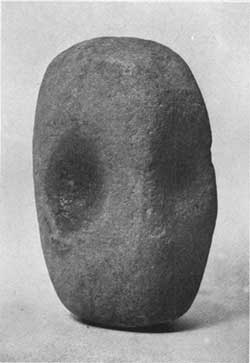
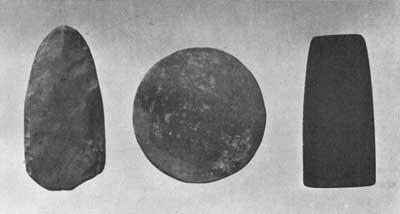
Plate 22. STONE OBJECTS (aPounding stone (top), bProjectile
point, cCover for vase, dFlat stone slab (bottom, left to right))
|
GRINDING STONES
The most common variety of grinding stones is, of
course, the metate, or mill-stone, used in grinding corn. These
implements have a variety of forms. They may be flat above and rounded
below, or flat on both sides, triangular on each face, or simply convex
on each side. None of them have feet like the Mexican metates. The stone
with which the grinding was done, or the one held in the hand, also
varies in shape, size, and evidences of use.a Stones with a
depression in one face served as mortars. A stone in the form of a
pestle, flat on the end, served as a paint grinder. Several flat stones
with smooth surface, showing the effect of grinding, and others with
slight concavities, undoubtedly served the same purpose. Smooth stones
showing grinding on one or more faces were evidently the implements with
which the builders smoothed the walls of the houses after the masonry
had been laid; others were used in polishing pottery.
aAt several places on the surfaces of
projecting rocks forming the foundations of buildings may be noticed
grooves where metates were sharpened. One or more of these occur at the
entrance to the "street" in front of room 51. The foundation of a wall
in one room was built directly upon one of these grooves, part of the
groove being in sight, the rest covered with masonry. Near room 92 there
are many of these grooves as well as small pits.
MISCELLANEOUS STONES
Many stone balls, large or small, were found. Some of
these show chipping, others are ground smooth. Certain of these balls
were evidently used in a game popular at Cliff Palace, in which they
were rolled or dropped into deep pits and grooves. It appears that this
game was played by occupants of the sacred rooms, as the pits are common
in the kiva floors. Other stone balls were formerly tied to the end of a
handle with a thong of hide and used as a weapon.
A half oval stone, smooth and flat at one pole, is
supposed to have been an idol, possibly the earth goddess, who is
repeatedly represented by the Hopi in a similar way. It was left near
where it was found at the northwest corner of kiva H. Our masons used
rectangular slabs of soft stone, which were doubtless door-closes, as
mortar boards. They were held in place in the door opening by jambs made
of mortar laid on sticks, and by a horizontal rod which passed between
two osier eyelets set in the uprights of the door-frame and projecting
from it. These stone doors were sometimes held in place by a groove cut
in the threshold or by a ledge of adobe.
Two thin, flat, circular stone disks (pl. 22, c),
with smooth surfaces and square edges, accompanied the calcined human
bones in the inclosure at the northern end of the large refuse heap. It
is probable that some of these disks were used as covers for mortuary
vases. Irregularly shaped flat stones with pits and incised figures
pecked in their surface were used in a game, and a slab covered with
incised figures but without the pits (pl. 23, c) probably served a
similar purpose.
Several large stones, which the builders of Cliff
Palace had begun to dress and had later rejected, show the method
adopted by them in cutting stones the required size. When stones were
found to be too large to be laid, or had projections that interfered
with the required shape, a groove was pecked where the fracture was
desired and the stone broken along the groove.
POTTERY
No ruin in the Mesa Verde National Park has yielded
more specimens of pottery than Cliff Palace, many pieces of which are
preserved in various museums in Colorado and elsewhere. The collection
gathered by the writer was small compared with some of these, and
although only a few whole pieces were found, by restoration from
fragments a fair number of specimens, ample perhaps for generalization,
were procured. In the following mention of the pottery obtained from
the ruin a very comprehensive idea of the perfection in the ceramic art
attained in Cliff Palace can hardly be hoped.
Southwestern pottery may be divided into two types,
so far as superficial appearance goes; (1) coiled or indented
undecorated ware; (2) smooth polished ware. Of the latter there are two
subtypes; (a) pottery with a surface slip, generally white, on which
designs are painted, and (b) decorated pottery without a
superficial slip, and generally reddish in color. Cliff Palace pottery,
when decorated, belongs to the last two divisions, but some of the best
made specimens belong to the coiled or indented type. Although there are
several fragments of red pottery ornamented with designs painted in
black, and one or two specimens in which the basal color is orange, the
majority of the specimens belong to the so-called black-and-white ware,
which may therefore be called a type of this region.
The whole pieces of pottery collected were chiefly
mortuary vessels, and probably contained food offerings, indicating,
like the sipapus in the kivas, that the cliff-dwellers had a distinct
conception of a future life. In addition to the limited number of pieces
of unbroken pottery, many of the fragments were decorated with novel
patterns. Fragments of corrugated and indented ware are by far the most
numerous, but although many of these were obtained, not a whole piece
was found, with the exception of a single specimen plastered in a
fire-hole and three others similarly fixed in the banquettes of kivas.
These were left as they were found.
The same forms of pottery, as dippers, ladles, vases,
canteens, jars, and similar objects, occur at Cliff Palace as at
Spruce-tree House (pl. 23-27). All varieties were repeatedly found,
some with old cracks that had been mended, and one is still tied with
the yucca cord with which it had been repaired. It is evident from the
frequency with which the Cliff Palace people mended their old pottery
that they prized the old vessels and were very careful to preserve them,
being loth to abandon even a cracked jar (pl. 23, d). None of the
Cliff Palace pottery is glazed.a Some specimens of smooth
pottery are coarse in texture and without decoration; others have
elaborate geometrical figures; but animate objects are confined almost
entirely to a few pictures of birds or other animals and rudely drawn
human figures. The pictography of the pottery affords scant data bearing
on the interpretation of the ancient symbolism of the inhabitants, as
compared with that of Sikyatki, for example, in the Hopi country.
aThe first description of "glazed" pottery in
the Pueblo region is given by Castañeda (1540), who says: "Throughout
this province [Tiguex] are found glazed pottery and vessels truly
remarkable both in shape and execution." This has sometimes been interpreted
to mean the glossy but unglazed pottery of Santa Clara. Glazed
pottery was found by the writer in 1896 in ruins on the Little Colorado.
It appears to be intrusive in the Arizona ruins.
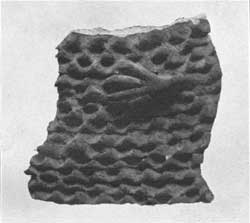
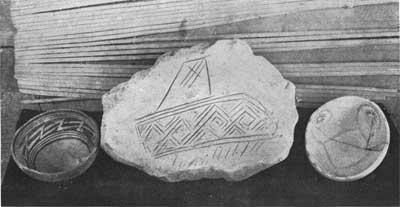
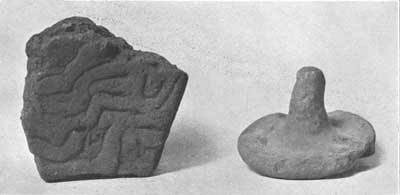
Plate 23. VARIOUS OBJECTS FROM CLIFF PALACE
(aPottery fragment with bird-claw decoration in relief (top),
b, dFood bowls, cIncised stone (middle, left to right),
eDecorated fragment of earthware, fCover for vase
(bottom, left to right))
|
Food bowls.—In form the food
bowlsb from Cliff Palace (pls. 23-25) are the same as those
from other prehistoric sites of the Southwest, but as a rule the Cliff
Palace bowls are smaller than those of Sikyatki and the ruins on the
Little Colorado. They have, as a rule, a thicker lip, which is square
across instead of tapering to a thin edge or flaring, as is sometimes
the case elsewhere. The surface, inside and out, is commonly very
smooth, even glossy. The pottery was built up by coiling the clay, and
the colors were made permanent by the firing.
bFood bowls with handles, so common to the
ruins of northern Arizona, were not found at Cliff Palace.
The basis of the study of symbolism was of course the
pottery decoration. As a rule the center of the inside of the food
bowls is plain, but several have this portion ornamented with squares,
triangles, and other figures. The outside of several bowls from Cliff
Palace and Spruce-tree House is decorated, notwithstanding Nordenskiöld
speaks of exterior decoration as rare in his collections from the Mesa
Verde. The geometric ornaments consist of rectangular
figures.a
aNo curved lines are present in the many
examples of decoration on the outside of food bowls from Sikyatki.

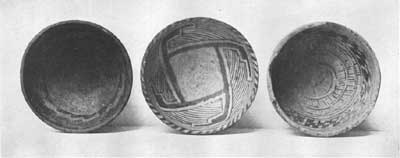
Plate 24. FOOD BOWLS
|
Mugs.—Some authors have questioned
whether the prehistoric people of the Southwest were familiar with this
form of pottery. The collections from Cliff Palace (pl. 24-26) and
Spruce-tree House set at rest any reasonable doubt on this point. There
are, however, peculiarities in the form of mugs from Mesa Verde. The
diameter of the base is generally larger, tapering gently toward the
mouth, and one end of the handle is rarely affixed to the rim. The
inside of the mug is not usually decorated, but the exterior bears
geometrical designs in which terraces, triangles, and parallel lines
predominate. Curved lines are rare, and spirals are absent. Mugs with
two handles are unrepresented. There are no ladles in the collection,
but several broken handles of ladles were found in the refuse. One of
these is decorated with a series of parallel, longitudinal, and
transverse lines, a design as widely spread as Pueblo pottery, extending
across the boundary into Mexico.
Globular Vessels.—The globular form of
pottery was used for carrying water and seems to have been common at
Cliff Palace. One of these vessels (pl. 25, b) has a small neck,
and attached to it are two eyelets for insertion of the thong by which
it was carried. Some of the globular vessels (pl. 25, a) have the neck
small, the orifice wide, and the lip perforated with holes for strings.
Double-lipped globular vessels, having a groove like that of a teapot,
have been found in Cliff Palace as well as in other ruins of Mesa Verde
and Montezuma canyon. The rims of these are generally perforated, as if
for the insertion of thongs to facilitate carrying. The bottoms of these
vessels are rarely concave. They are sometimes decorated on the outside,
but never on the interior.
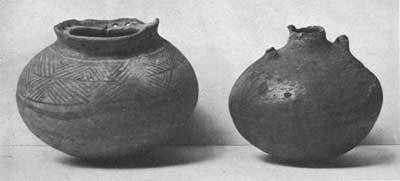

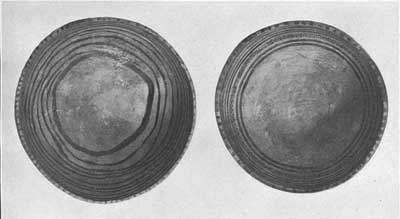
Plate 25. VASES AND FOOD BOWLS
|
Vases.—Small vases with contracted neck
and lip slightly curved, and larger vases with the same characters,
occur sparingly. These (pls. 26, 27, b) are decorated on the
exterior in geometrical designs; the interior is plain. The bases are
rounded, sometimes flat, and in rare instances concave.
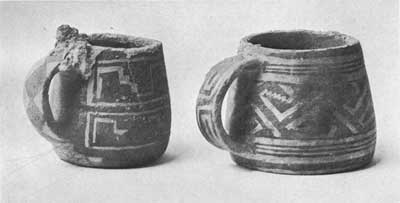
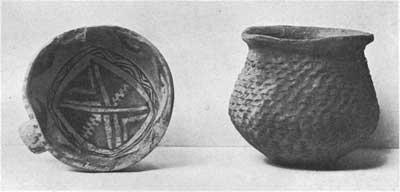
Plate 26. POTTERY (a mugs from
crematory (top); b dipper-bowl and corrugated vase
(bottom))
|
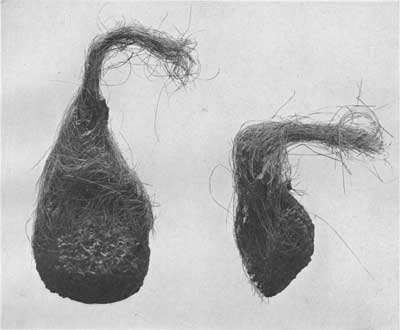
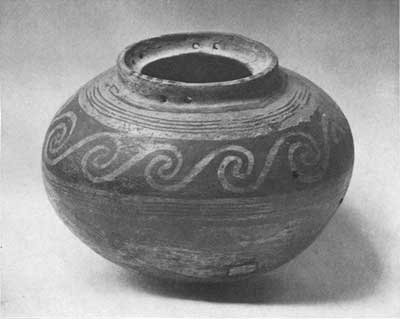
Plate 27. PITCH BALLS AND VASE
|
Disks.—Among pottery objects should be
mentioned certain disks, some large, others small, some perforated in
the middle, others imperforate. Several are decorated. These disks
served as covers for bowls, and similar disks were employed as counters
in games or as spindle whorls. None of the clay disks from Cliff Palace
has a central knob or handle like those from Spruce-tree House.
RELATIONS AS DETERMINED BY POTTERY
In the report on Spruce-tree House, using pottery as
a basis, the prehistoric culture of the Southwest, including the
Gila-Salt area, which can not strictly be designated Pueblo, has been
provisionally divided into several subcultural areas. Among these are
the Hopi, a specialized modification of the Little Colorado, the Little
Colorado proper, the San Juan, and the Gila-Salt areas.
Cliff Palace pottery symbols are not closely related
to those on old Hopi ware, as typified by the collections from
Sikyatki.a Neither Cliff Palace nor Spruce-tree House pottery is
closely allied to that of the Little Colorado, as exemplified, by
Homolobi ware, but both have a closer likeness to that from Wukoki, a
settlement ascribed to the Snake clans, situated near Black Falls, not
far from Flagstaff, Arizona. As a rule the symbolism on pottery from
the Little Colorado, which includes that of its upper tributaries, as
the Zuñi, Puerco, Leroux, and Cottonwood washes, is a mixture of all
types. This river valley has exerted a distributing influence in Pueblo
migrations, and in its ruins are found symbols characteristic of many
clans, some of which, following up the tributaries of the Salt and the
Gila, have brought Casas Grandes decorative elements; others, with
sources in the northeast, have contributed designs from an opposite
direction. The predominating directions of ceramic culture migration in
this valley have been from south to north and from west to
east.b
aSikyatki ware is more closely related to that
of the ancient Jemez and Pajarito subarea than to that made by the
Snake clans when they lived at Tokónabi, their old home, or at Black
Falls shortly before they arrived at Walpi. Careful study of ancient
Walpi pottery made by the Bear clan before the arrival of the Snake
clans shows great similarity to Sikyatki pottery, and the same holds
regarding the ware from old Shongopovi.
bIn the ruins found on the banks of the Little
Colorado at Black Falls, the predominating influence, as shown by
pottery symbols, has been from the north. It is known from legends that
Wukoki was settled by clans from the north, the close likeness to the
symbols of the San Juan valley supporting traditions still current at
Walpi.
The relation of Cliff Palace pottery designs to the
symbolism or decorative motives characteristic of the Gila valley ruins
is remote. Several geometrical patterns are common to all areas of the
Southwest, but specialized features characterize each of these areas.
The pottery from Cliff Palace finds its nearest relation throughout the
upper San Juan region; the most distant to that of ruins in northern
Arizona near Colorado Grande.c
cA thorough comparative study of Pueblo
pottery symbolism is much restricted on account of lack of material from
all ceramic culture areas of the Southwest. It is likewise made
difficult by a mixture of types produced by the migration of clans from
one area to another. The subject is capable of scientific treatment, but
at present is most difficult of analysis.
SYMBOLS ON POTTERY
The symbols on the Cliff Palace pottery are reducible
to rectangular geometrical figures; life forms, with the rare exceptions
noted above, are not represented, and the exceptional examples are
crude. Contrast this condition with the pottery from Sikyatki, where
three fourths of the decorations are life designs, as figures of men or
animals, many of which are highly symbolic. The "sky band" with
hanging bird design, peculiar to old Hopi ware, was unknown to Cliff
Palace potters. Encircling lines are unbroken, no specimen being found
with the break so common to the pottery from the Hopi, Little Colorado,
Gila, and Jemez subareas. The designs on food bowls are often
accompanied with marginal dots. No example of the conventionalized
"breath-feather" so common in Sikyatki pottery decoration occurs.
Spattering with color was not practiced.
An analysis of the pottery decorations shows that the
dominant forms may be reduced to a few types, of which the terrace, the
spiral, the triangle, and the cross in its various forms are the most
common.
Various forms and sizes of triangles, singly or in
combination, constitute one of the most constant devices used by the
cliff-dwellers of the Mesa Verde in the decoration of their pottery. It
is common to find two series of triangles arranged on parallel lines.
When the component triangles are right-angled they sometimes alternate
with each other, forming a zigzag which may be sinistral or dextral.
This design may be called an alternate right-angular figure.
If instead of two parallel series of right-angle
triangles there are isosceles triangles, they may be known as alternate
isosceles triangles. These triangles, when opposite, form a series of
hour-glass figures or squares. This form is commonly accompanied by a
row of dots, affixed to top and base, known as the dotted square or
hour-glass figure. Hour-glass designs are commonly represented upright,
but the angles of the triangles may be so placed that the series is
horizontal, forming a continuous chain. Often the bases of these serially
arrayed hour-glass figures are separated by rows of dots or by blank
spaces.
A row of triangles, each so placed that the angles
touch the middles of the sides of others in the same series, form an
arc called linear triangles. The St. Andrews cross, which occurs
sparingly on Mesa Verde pottery, is formed by joining the vertical
angles of four isosceles triangles.
The cross and the various forms of the familiar
swastika also occur on Cliff Palace pottery. The star symbol, made up of
four squares so arranged as to leave a space in the middle, is yet to be
found in Mesa Verde. Parallel curved lines, crooked at the end or
combined with triangles and squares, occur commonly in the pottery
decoration of Cliff Palace. S-shaped figures are known. Rectangles or
triangles with dots, or even a line of dots alone, are not rare in the
decoration. No designs representing leaves or flowers occur on pottery
from Cliff Palace, nor has the spider-web pattern been found. The most
common geometrical decorations are the stepped or terraced figures,
generally called rain-clouds.
POTTERY RESTS
Among the objects found in the refuse heaps of Cliff
Palace are rings about 6 inches in diameter, woven of corn husks or
cedar bark bound together with fiber of yucca or other plants. These
rings (pl. 28) were evidently used as supports for earthenware vases,
the bases of which are generally rounded, so that otherwise they would
not stand upright. Similar rings may have been used by the women in
carrying jars of water on their heads,a as among the Zuñi of
to-day. Some of these rings may have been used in what is called the
"ring and dart" game, which is often ceremonial in nature. The best made
of all these objects, found by Mr. Fuller on his visit to a neighboring
canyon, is shown in the accompanying illustration (pl. 28, b).
The specimen is made of tightly woven corn husks, around which the fiber
is gathered so as to form an equatorial ridge rarely present in these
objects.
aThe Hopi use large clay canteens for this
purpose, no vessels resembling which, whole or in fragments, have been
found at Cliff Palace.

Plate 28. RESTS FOR JARS
|
BASKETRY
A few instructive specimens of basketry or wicker
ware were exhumed at Cliff Palace. One of the most interesting of these
is the unfinished plaque shown in the accompanying figure 2.

FIG. 2.—Coil of basket plaque.
|
One specimen of basketry (pl. 29) has the form of a
hopper; its whole central part was purposely omitted, but the basket is
finished on the inner and outer margins. It recalls a basket used by the
Ute and other Shoshonean Indians, but it is different in form from any
figured in Nordenskiöld's work, and, so far as the author is acquainted
with other specimens of basketry from Mesa Verde ruins, is unique. It is
supposed that when used this hopper was placed on a flat or rounded
stone and that corn or other seeds to be pounded were placed in it, the
stone thus forming the surface upon which the seeds were treated, and
the sides of the basket serving to retain the meal.
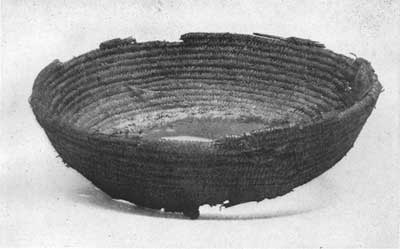

Plate 29. BASKET HOPPER—SIDE AND BOTTOM VIEWS
|
SANDALS
The sandals found at Cliff Palace (pls. 30-32)
are practically the same in form, material, and weave as those recorded
from Spruce-tree House. The shape of these, however, is particularly
instructive, as it appears to shed light on the meaning of certain flat
stones, rare in cliff-dwellings, called "sandal lasts." These stones,
one of which is figured in the report on Spruce-tree House, are
rectangular, flat, thin, smooth, with rounded corners, and sometimes
have a notch in the rim at one end. The exceptionally formed sandal from
Cliff Palace (pl. 32) is similar in shape and has a notch identical with
that of the problematical stone objects, supporting the theory that the
latter were used as sandal lasts, as interpreted by several authors.
The sandals are ordinarily made of plaited yucca
leaves, their upper side being sometimes covered with corn leaves for
protection of the feet. The thongs that passed between the toes are
made either of yucca or other vegetable fiber, or of hide.
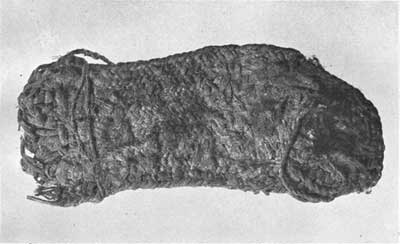
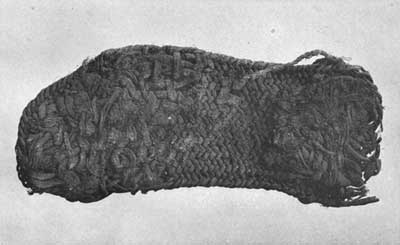
Plate 30. SANDALS
|
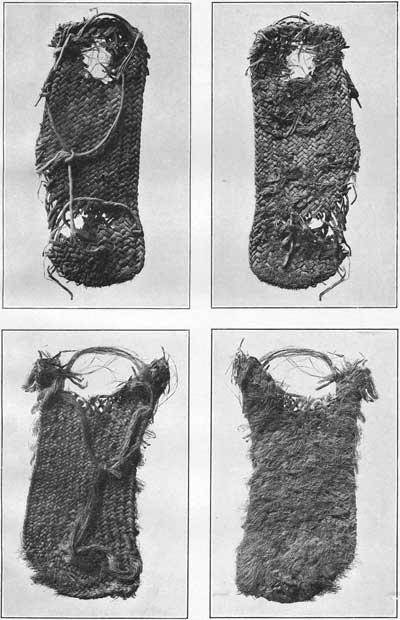
Plate 31. SANDALS
|
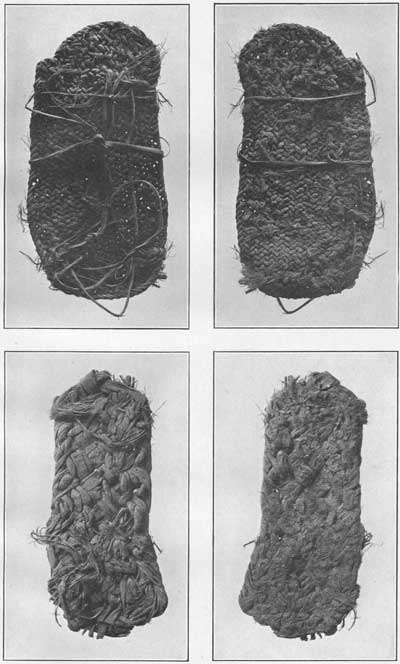
Plate 32. SANDALS
|
WOODEN OBJECTS
There are several objects made of wood in the
collection from Cliff Palace. some of the least problematical of which
are long, pointed rods (fig. 3) with which the ancients probably made
the holes in which they planted corn, in much the same way as the Hopi
plant at the present day. These implements are commonly pointed at the
end, but one, or two are broadened and flattened. No example of the
spatular variety of dibble found by others, and none showing the point
of attachment of a flat stone blade, occurs in the collection. One or
two short broken sticks, having a knob cut on the unbroken end, are
interpreted as handles of weapons—a use that is not definitely
proven. There are several sticks that evidently were used for barring
windows or for holding stone door-closes in place.
Among problematical wooden objects may be mentioned
billets (pl. 33), flattened on one side and rounded at each end. Two of
these were found, with calcined human bones, in the inclosure used for
cremation of the dead, situated at the northern end of the large refuse
heap. These, like the bowls with which they were associated, were coated
with a white salt-like deposit. None of the many wooden objects figured
by Nordenskiöld are exactly the same as those above mentioned, although
the one shown in his plate XLIII, figure 17, is very close in form and
size.

|
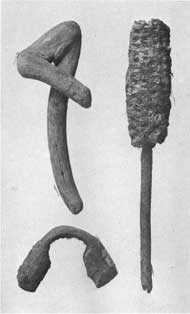
|

|
|
Plate 33. WOODEN OBJECTS (a billet
(left); b objects used in game (middle); c billet
(right))
|
Several bent twigs or loops of flexible wood from the
refuse heaps were found; these are supposed to have been inserted in the
masonry, one on each side of door and window openings, to hold in place
the stick which served as a bolt for fastening the door or window stone
in position.
Bent sticks, of dumb-bell shape, having a knob at
each end (pl. 33, b), are believed to have been used in games. A
similar object from the Mancos region is figured by Mr. Stewart Culin in
his account of the games of the cliff-dwellers.a The ancient
people of the semi-deserts of Atacama, in South America, employed a
similar but larger stick, to which cords were attached for strapping
bundles on their beasts of burden.
aTwenty-fourth Annual Report of the Bureau
of American Ethnology.

FIG 3. —Planting sticks
|
DRILLS
A small pointed stone attached with fiber to the end
of a stick, similar to those found by Nordenskiöld in ruin 9 and at Long
House, was found.
The Cliff Pahace people kindled fire by means of the
fire-drill and fire-stick (hearth), a specimen of which, similar to one
collected at Spruce-tree House, is contained in the collection. Both of
these fire-making implements were broken when found, apparently thrown
away on that account either by the original people or by subsequent
visitors.
BONE IMPLEMENTS
Many bone implements (pl. 34, 35) were found during
the excavation of Cliff Palace. They are of the bones of birds and small
mammals, or, now and then, of those of antelope or bear, the latter
furnishing the best material for large scrapers. These implements were
evidently sharpened by rubbing on the stones of walls or on the face of
the cliff, as grooves, apparently made in this way, are there visible in
several places. Scratches made in shaping or sharpening bones,
repeatedly found on the masonry of Cliff Palace, are not peculiar,
resembling those referred to in the report on Spruce-tree House. A small
tube with a hole midway of its length doubtless served as a whistle,
similar instruments being still often used in Hopi ceremonies to imitate
the calls of birds.
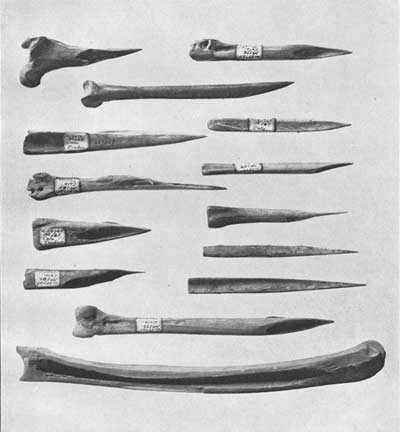
Plate 34. BONE IMPLEMENTS
|
Sections of bones were found tied in pairs, and while
it is not clear that these were threaded on a cord and worn as necklaces
or armlets, as Nordenskiöld suggests, they may have been tied side by
side, forming a kind of breastplate not unlike that used by the Plains
tribes. In a room of Spruce-tree House, according to Nordenskiöld, eight
similar pieces of bone were found strung on a fine thong of hide.
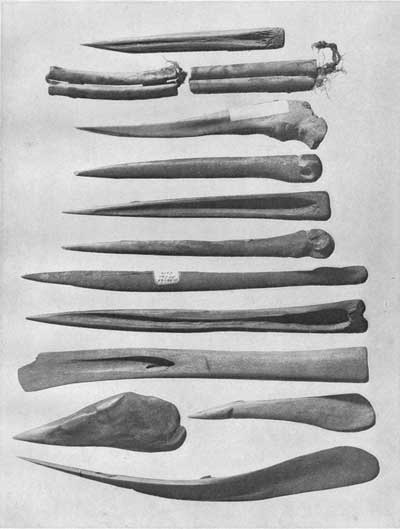
Plate 35. BONE IMPLEMENTS
|
Among other bone objects there is one, of unknown
use, about an inch long and one-fourth of an inch in diameter, nearly
cylindrical in shape. A bone with a hole in one end, similar to those
figured by Nordenskiöld, forms part of the collection.
TURQUOISE EAR PENDANTS AND OTHER OBJECTS
The single specimen of turquoise found at Cliff
Palace was probably an ear pendant, and a black jet bead was apparently
used for the same purpose. With the polished cylinder of hematite found
one can still paint the face or body a reddish color, as the Hopi do
with a similar object. From the sipapu of kiva D there was taken a small
deerskin bag, tied with yucca fiber and containing a material resembling
iron pyrites, evidently an offering of some kind to the gods of the
underworld.
A button made of lignite, and beads of the same
material, were found in the refuse heap in front of the ruin after a
heavy rain. The former is broken, but it resembles that found at
Spruce-tree House, although it is not so finely made, and also one from
Homolobi, a ruin on the Little Colorado, near Winslow, Arizona.
SEEDS
The cobs and seeds of corn, squash and pumpkin seeds,
beans, and fragments of gourds give some idea of the vegetable products
known to the Cliff Palace people. Corn furnished the most important food
of the people, and its dried leaves, stalks, and tassels were abundant
in all parts of their refuse heaps. Naturally, in a cave where many
small rodents have lived for years, it is rare to find seed corn above
ground that has not been appropriated by these animals, and in the dry,
alkaline bone-phosphate dust edible corn is not very common, although
now and then occurs a cob with attached seeds. The corn of Cliff Palace,
already figured by Nordenskiöld, resembles that still cultivated by some
of the Hopi.
TEXTILES

FIG. 4.—Woven forehead band.
|
The Cliff Palace people manufactured fairly good
cloth, the component cords or strings being of two or three strands and
well twisted. So finely made and durable are some of these cords that
they might be mistaken for white men's work; some of them, however,
are very coarse, and are tied in hanks. Among varieties of cords may be
mentioned those wound with feathers, from which textiles, employed in
the manufacture of ordinarily called "feather cloth," was made. Yucca
and cotton were almost all kinds of fabrics. A few fragments of netting
were found.
The finest cloth was manufactured from cotton,
a good specimen of which, showing a pattern woven in different colors,
is contained in the collection.
Several woven belts, and also a head-band similar to
that figured in the report on Spruce-tree House, were uncovered by the
excavations.
The largest fragment of cloth was taken out of the
crematory, or inclosure containing the calcined human bones, at the
northern end of the larger refuse heap. It appears to have been a
portion of a bag, or possibly of a head covering, but it is so
fragmentary that its true use is unknown. The pattern is woven in darker
colored threads, with a salvage at two ends. The material out of which
it was made has not been definitely determined, but it closely resembles
that of the specimen figured by Nordenskiöld (plate L) from Mug House.
Our excavations were rewarded with a fine woven head-band with loops at
the ends (fig. 4), similar to that described and figured in the report
on Spruce-tree House. Several small fragments of cloth were recovered
from the refuse heap, but none of them was large enough to indicate the
form of the garment to which they originally belonged.
In the group of fabrics may be included nets and
cloth with feathers wound around warp and woof, similar to those figured
from Spruce-tree House.
There were several specimens of yucca strings, tied
in loops, generally six in number, which presumably were devoted to the
same purpose as by the present Hopi, who attach to the string six ears
of corn, representing the cardinal points on the six-directions altar,
and hang them on the walls of a priest's house. If the cliff-dwellers
used this string for a similar purpose, it would appear that they, like
the Hopi, recognized six cardinal points—north, west, south, east,
above, and below—and worshiped gods of these directions, to which
they erected altars.a
aFor a Hopi six-directions altar, see
Journal of American Ethnology and Archleology, vol II, 1892.
|

|



